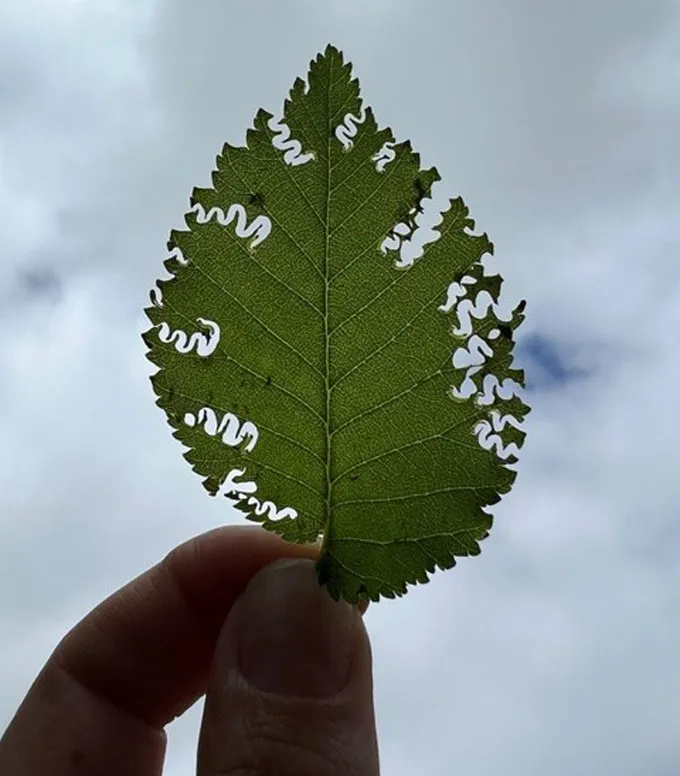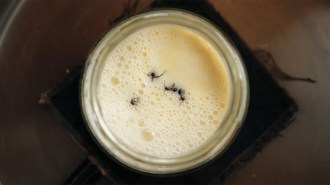
Originally from East Asia, the elm zigzag sawfly has expanded its range across North America at a rate that alarms biologists
jobangles/iNaturalist
She’s less than a centimeter long, produces only daughters and is conquering the continent without a single male. Meet the elm zigzag sawfly, named for the delicate zigzag patterns it carves into elm tree leaves.
Despite its name, the elm zigzag sawfly (Aproceros leucopoda) is not a fly; it is a type of wasp first discovered in North America in 2020. Originally from East Asia, it has expanded its range at an “alarming” rate, researchers report in the Journal of Integrated Pest Management. For cities still recovering from elm canopies lost to a fungal disease, it’s an unwelcome second wave of assault. And newly emerging evidence suggests it won’t stop at elms.
In just over five years, the pest has spread to 15 U.S. states, from New Hampshire to Minnesota and south to North Carolina, says Kelly Oten, an entomologist at North Carolina State University in Raleigh. “We just had to add Indiana,” says Oten, who maintains a map of elm zigzag sawfly sightings.
Freshly hatched elm zigzag sawflies cut zigzagging lines into leaves. “The feeding pattern is oddly cute,” Oten says. But as the larvae mature, they can strip enough foliage from a tree to leave it almost bare.

To see if the wasp would attack trees beyond elms, Oten’s team planted Japanese zelkova (Zelkova serrata) near an infestation site in Ohio. Many U.S. cities have started planting zelkovas, an elm relative, since they appear resistant to Dutch elm disease, the fungal affliction that has killed tens of millions of American elms in the last century.
The researchers observed the wasp laying eggs, feeding, pupating and emerging as adults on zelkova saplings, which produce new leaves earlier than elms in the spring. As the season progressed, the wasp switched back to elms, suggesting that zelkova may serve as an alternate host when elm foliage isn’t available, the researchers say.
The finding surprised Véronique Martel, a forest entomologist with Natural Resources Canada who reported North America’s first elm zigzag sawfly detection in the province of Quebec in 2020. “It is rare that insects can switch hosts,” she says. Martel, who wasn’t involved in the study, suspects that being able to feed on zelkovas could make the wasps even more successful, by allowing them to start multiplying earlier in the year. “They can make a lot of generations within a summer,” she says.
A crucial driver behind the zigzag sawfly’s rapid spread is an unusual reproductive strategy called thelytokous parthenogenesis, in which females lay unfertilized eggs that produce only more females. This means that even a single egg hitching a ride on firewood or a car can start a new infestation. No males have ever been found.
For reasons researchers don’t yet understand, the zigzag sawfly larvae cut only minor zigzag patterns in some elms while severely defoliating elms in other areas. “At this point, we do not know if it’ll kill the tree or just stress it greatly,” Oten says.
Unwitting human accomplices have probably aided the sawfly’s rapid spread. Oten’s team documented cocoons with elm zigzag sawfly pupae clinging to truck mirrors and wheel wells, which can carry the insect far beyond its natural dispersal range of 45 to 90 kilometers annually. Researchers think the pest may have arrived in North America hidden in the soil of a houseplant.
With elms native across most of the eastern United States and Canada, elm zigzag sawflies have a vast territory available. “I do think we will have many more reports in additional counties and likely more states” in 2026, Oten says. Temperature extremes may eventually limit the insect’s range, she notes. “But as of right now, it’s North Carolina to Canada. That’s pretty wide.”
Oten is testing pesticides to help homeowners protect their trees. Early trials of two soil-applied insecticides show promise, and she expects to publish the full results within months. For now, she recommends checking vehicles for cocoons before leaving infested areas and reporting zigzag patterns to local extension offices.






